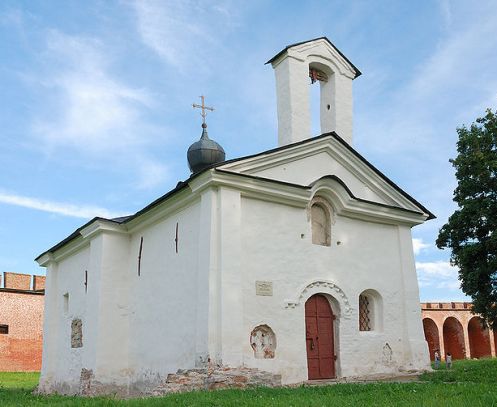

Church of Andrew Stratelas is a Russian Orthodox church located in the Eastern part of medieval Novgorod Kremlin. Original church was erected in 1167- 73 and dedicated to Saint Boris and Gleb, Russian princes- martyrs. However in 1405 original church was burned down. A new church was erected on the base of the original building. Most recent reconstruction occurred in the late 17th century when it was badly damaged by Swedish troops.
Initially, on the site of the church in 1167-1173, a
stone temple of Boris and Gleb was built - a majestic, three-apse,
six-pillar building with a stair tower. In 1405, due to a fire that
engulfed the Lyudin end, the church was badly damaged and in 1441, by
decree of Archbishop Euthymius II, a new church was built on the old
foundation. During construction, the stair tower was dismantled and on
its basis a separate chapel of Andrei Stratilat was built.
Rebuilt in the 15th century, the Borisoglebsky Cathedral is depicted on
the icon “The Vision of Sexton Tarasius” of the late 16th century,
decorated with a huge fresco-icon and crowned with two domes. One of
them (small) symbolically indicates the existence of the chapel of
Andrei Stratilat. You can quite clearly see the aisle of Andrei
Stratilat on the Swedish plan of 1611, where it is shown from the south
near the single-domed main volume.
During the conquest of
Novgorod by the Swedes at the beginning of the 17th century, the
cathedral was severely destroyed. In 1682, the Borisoglebsky Cathedral
collapsed and was dismantled to the ground, and the preserved chapel of
Andrei Stratilat was expanded to the east and turned into an independent
church.
Thus, the present building is the result of two major
construction periods. The walls of the western volume and the northern
wall of the eastern extension are preserved from the 15th century. They
are made of Volkhov flagstone, shell rock and brick. The architectural
design of the western portal with an arched top, a decorative edge on
the outside and a triangular lintel inside is typical of the Novgorod
architecture of the 15th century. The eastern and part of the southern
wall, as well as the vaults, were built of brick in the 17th century.
In the first half of the 19th century, the temple was rebuilt. Then
a new vault was built in the western volume and a new cornice, the roof
was replaced, a small cupola and belfry were made, and the foundations
under the northern wall were strengthened.
During the Great
Patriotic War, the church was damaged: the roof was damaged, the plaster
crumbled, the floors were dismantled.
In 1947 the building was
renovated. In 1969, under the guidance of Professor M.K. Karger,
research was carried out on the foundations of the 12th century
staircase tower inside and outside the western volume of the church. The
lower sections of the walls and the well-preserved masonry of the
central round pillar with several steps of a spiral staircase were
discovered.
In the 1970s, the condition of the monument began to
deteriorate sharply - the walls began to crack. Under the guidance of
the architect of the Novgorod restoration workshop G. M. Shtender,
emergency response work was carried out.
In 2000-2003,
restoration work was carried out by the Desna company according to the
projects of O. N. Kovalenko and L. G. Markova. In the process of work,
the supporting structures of the building were strengthened: masonry
walls, vaults, foundations. The floor in the western volume was laid out
of limestone slabs in such a way as to reveal the shape of the round
base and the walls of the stair tower. At the same time, under the
guidance of E. I. Seryogina, the artists-restorers of the Interregional
Scientific and Restoration Artistic Administration of Moscow uncovered
and strengthened the wall paintings of the 16th-17th centuries inside
the temple.
On the northern wall of the western volume of the
church, in lower register, there is a procession of saints facing the
altar. Andrey Stratilat is the first to be presented from the east.
On the western cheek of the triumphal arch in the center is the
composition "The Sign of the Mother of God" in a medallion - an image
especially revered in Novgorod. On either side of it are images of the
biblical kings David and Solomon and unknown saints in medallions.
On the walls of the western volume, in the upper register, a
grandiose composition "The Ascension of Christ" has been fragmentarily
preserved. On the southern and northern walls there are 12 apostles in
height, in a three-quarter turn, facing the Mother of God. Her image is
written on the western wall. Behind the Mother of God are two angels in
white robes. Only the lower parts of the figures of the Mother of God
and the angels survived. Of the 12 apostles, only one had a personal
letter. The rest of the faces were lost during the construction of the
late vault. The image of Christ in radiance with angels and seraphim,
which was on the lost vault, also perished.